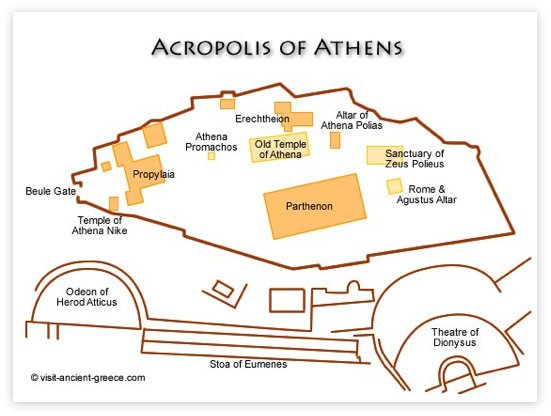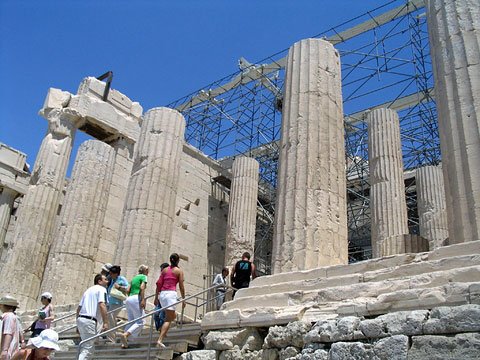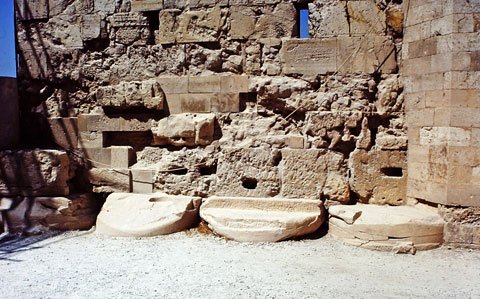The Athenian Acropolis is one of the most famous views in the world. Visitors travel from far and wide to see it. An outcrop of limestone about 156m high (512ft), it rises from the plain of Attica. Today it is surrounded by the modern buildings of the city, and although still an imposing sight, in antiquity it must have been even more amazing.
Summer 2023
Due to large crowds waiting in heat new access procedures will be implemented in July. Plan ahead to visit.

First impressions
When you see the acropolis from anywhere in Athens it looks quite imposing. Fortunately you can only get close to and enter it the same way the ancients did – on foot. This way you gradually come to appreciate the size and achievements of the site and its buildings.
You approach it from the west, up some steps which weave their way up the hill. In Roman times the approach would have been straight up a marble stairway through what was known as the Beulé Gate, named after the French archaeologist Ernest Beulé who discovered it.

The Propylaea
As you get closer to the first set of columns, you begin to appreciate the size of the structures. Towering above you on the right is the little temple of Athena Nike (victory). Now the sheer magnitude of the place starts to impress you.

The design of the Propylaia leads you through onto the acropolis itself. As you go through you suddenly catch sight of the Parthenon. This is no accident, as the whole idea was to impress both citizens and visitors to the city with its greatness, expressed in the crowning glory of Athens – the Parthenon, the temple to Athena Parthenos.
Straight in front of you is the site of a bronze statue to Athena Promachos (Athena who leads in battle). This was a statue by the famous sculptor Phidias, and was 9m high (30ft). It was first erected in 454 BC, and was later taken to Constantinople. In 1203 it was destroyed during a siege by the crusaders.
To the south
If you stroll to the southern wall and look down you’ll see the Odeon of Herod Atticus. Herod was a great patron of the arts who lived from 101 – 177AD. The theatre has been reconstructed, and is used for plays and other events on a regular basis.
Continue walking and past the Odeon you’ll see the remains of the Stoa of Eumenes. This was a large hall used by visitors to the Theatre of Dionysus, which you can see further down at the bottom of the slope of the acropolis.

To the north
When you get to the east of the Parthenon (the Parthenon dominates the acropolis, we’ll leave it until last) turn north. You’ll come across the Rome and Augustus Altar. This was built by the Athenians in honour of Rome and the emperor Augustus.
A little to the north is the site of the sanctuary of Zeus Polieus. Now to your left is the site of the Altar of Athena. Beyond that is the site of the old temple of Athens. But because all you can see of that is a few slabs marking the outline, your interest will probably be taken up with the building just to the right, the Erechtheion.
The Erechtheion is a remarkable structure, with some interesting legends associated with it.

There’s another fascinating detail in the walls to the right of the Erechtheion. When the Athenians regained possession of the acropolis after they had defeated the Persians, they determined to keep the remains of the temples as they were, as a memorial. But later they decided to use the remains to fortify the walls. If you look closely, you can see where they inserted the old column sections into the walls to reinforce them.
The Parthenon
As you’ve walked along you can’t help noticing the Parthenon, which dominates everything on the acropolis. It’s only when you get close to it that you realise its sheer size. When you start to think of how we would go about building such a structure today, with computer aided design, project management, earth moving equipment and so on, the achievement of the Athenians was remarkable.
But when you learn more about the details of the Parthenon, of the subtleties of its design, then the skill and invention of the builders is even more amazing.